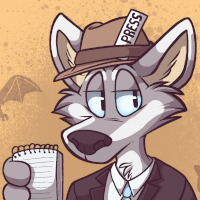Housepets! Let Instincts Do Their Thing (Book 8), by Rick Griffin – Book Review by Fred Patten
by Pup Matthias
Submitted by Fred Patten, Furry’s favorite historian and reviewer.
 Housepets! Let Instincts Do Their Thing (Book 8), by Rick Griffin
Housepets! Let Instincts Do Their Thing (Book 8), by Rick Griffin
Seattle, WA, CreateSpace, November 2017, trade paperback $13.95 (52 pages).
Ta-Dah! Here is the latest annual collection of the Housepets! online comic strip by Rick Griffin. Housepets! has appeared each Monday-Wednesday-Friday since June 2, 2008. It has won the Ursa Major Award for the Best Anthropomorphic Comic Strip for every year since! – for 2009, 2010, 2011, 2012, 2013, 2014, 2015, and now 2016.
Book 8 contains the strips from June 8, 2015 to June 3, 2016; story arcs #91, “The Plot Against Spot”, to #100, “The 4 Animals You Meet In Heaven”, plus the one-off gag strips between these.
Housepets! presents the adventures of the dogs, cats, ferrets, rabbits, and other pets of Babylon Gardens, a typical residential suburban neighborhood – in an alternate universe. The animals are larger than in our universe (but not human-sized), can talk, are usually bipedal, and address their human owners as “Mom” and “Dad”. Their status is somewhere between pets and children. Points established over the years are that humans can bequeath their belongings to their pets, who do not need a human guardian; human storekeepers are not allowed to sell catnip to cats; human police forces have an auxiliary of Police Dogs who are not all police dogs; the pets comment sardonically on how they can go naked in public but their human “parents” can’t; and – lots of other stuff.
But in Book 8, the housepets’ adventures often take them outside their suburban locale. Story arc #92, “All’s Fair, part 2”, is set in the huge back yard of the Milton ferrets’ estate, which Keene Milton has turned into a big amusement park and “Annual Foodapalooza Jamboree!”; maybe in Babylon Gardens but hardly part of a typical neighborhood scene. Arcs #93 to #95, “Housepets 5000 BC, parts 1-3”, introduce the large jackal Satau of the Merimde, Dragon’s second avatar, who gets sent from Ancient Egypt into the future and is drawn to Tarot the Pekinese dog, the demigod Dragon’s current (150th) avatar. Their attempt to send Satau home lands all of them (Satau and the dogs Peanut and Tarot, and the cats Grape, Maxwell, and Sabrina) in 5000 BC, the Neolithic Era, long before the building of the Pyramids and the Sphinx (to Max’s disappointment). There are rival kingdoms of the dogs and cats, and Grape is kidnapped by Ptah, the chief-king of the cats, to be his queen. (That’s Ptah and Satau arm-wrestling on the cover, with Grape and Peanut in the background.) #98, “Flip That Den!”, is in the forest outside Babylon Gardens, and #100, “The 4 Animals You Meet”, takes place in Heaven. Or a dream. Or somewhere.


 Ka: Dar Oakley in the Ruin of Ymr, by John Crowley. Illustrated by Melody Newcomb.
Ka: Dar Oakley in the Ruin of Ymr, by John Crowley. Illustrated by Melody Newcomb. Arcana: A Tarot Anthology, Madison Scott-Clary, ed. Illustrated by Joseph Chou.
Arcana: A Tarot Anthology, Madison Scott-Clary, ed. Illustrated by Joseph Chou. Myre: Chronicles of Yria, volume 1, by Claudya Schmidt and Matt W. Davis
Myre: Chronicles of Yria, volume 1, by Claudya Schmidt and Matt W. Davis Scurry: [Book 1] The Doomed Colony, by Mac Smith. Illustrated.
Scurry: [Book 1] The Doomed Colony, by Mac Smith. Illustrated. Marking Territory, by Daniel Potter. Illustrated by Johanna T.
Marking Territory, by Daniel Potter. Illustrated by Johanna T. Mist, by Amy Fontaine
Mist, by Amy Fontaine Oswald the Lucky Rabbit: The Search for the Lost Disney Cartoons, by David A. Bossert. Introduction by J. B. Kaufman. Illustrated.
Oswald the Lucky Rabbit: The Search for the Lost Disney Cartoons, by David A. Bossert. Introduction by J. B. Kaufman. Illustrated. ROAR volume 8, Paradise, edited by Mary E. Lowd.
ROAR volume 8, Paradise, edited by Mary E. Lowd.